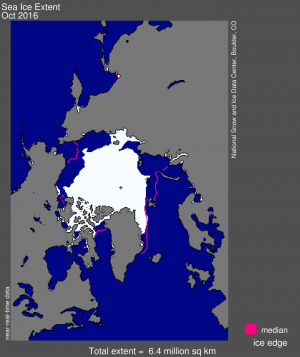New satellite data is proving what Canada’s Inuit have been saying for years: the oldest and thickest multiyear ice is thinning and melting away, leaving the younger seasonal sea ice more vulnerable to warming ocean and atmosphere.
The darker ocean attracts more sunlight, making it more difficult for new ice to form even when the winter sets in in the northern latitudes.
Despite a quick initial freeze-up during the second half of September, Arctic sea ice growth slowed substantially during early October, according to the U.S.-based National Snow & Ice Data Center.
Record low

The magenta line shows the 1981 to 2010 median extent for that month. The black cross indicates the geographic North Pole. (National Snow and Ice Data Center)
In October 2016, Arctic sea ice extent averaged 6.40 million square kilometers, the lowest October in the satellite record, according to the Colorado-based centre.
“This is 400,000 square kilometers lower than October 2007, the second lowest October extent,” the NSIDC said in a statement. “The average extent was 2.55 million square kilometers below the October 1981 to 2010 long-term average.”
Ice extent was especially low within the Beaufort, Chukchi, East Siberian, and Kara Seas, the data analysis centre said.
Double whammy
Arctic sea ice has not only been shrinking in surface area in recent years, it’s becoming younger and thinner as well, according to NASA.
“What we’ve seen over the years is that the older ice is disappearing,” Walt Meier, a sea ice researcher at NASA’s Goddard Space Flight Center in Greenbelt, Maryland, said in a recent report. “This older, thicker ice is like the bulwark of sea ice: a warm summer will melt all the young, thin ice away but it can’t completely get rid of the older ice.”
But this older ice is becoming weaker because there’s less of it and the remaining old ice is more broken up and thinner, so that bulwark is not as good as it used to be, Meier said.
In this NASA animation, Meier describes how the sea ice has undergone fundamental changes during the era of satellite measurements.
Credits: NASA’s Goddard Space Flight Center/Jefferson Beck, producer
On thin ice
The lower sea ice extent and thinner ice are making hunting and fishing particularly dangerous for Canada’s Inuit.
Moses Koonoo in Arctic Bay, Nunavut, was out hunting for seal and fishing for char this week. He told CBC News the sea ice was so thin he had to stay near the coast with his snowmobile not to break through.
Koonoo told CBC News the ice was about 8 cm thick when this time of year it’s supposed to be about 30 cm.
“The air seems to be cold, but the sea water must be warmer temperature,” he said. “It’s causing it to delay the forming of the ice.”
With files from CBC News







For reasons beyond our control, and for an undetermined period of time, our comment section is now closed. However, our social networks remain open to your contributions.